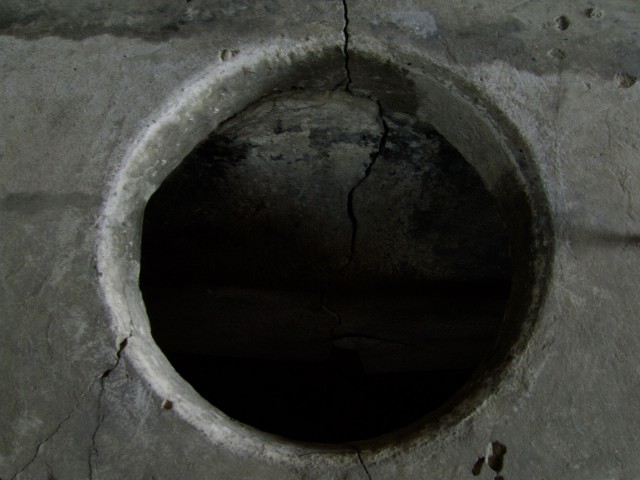At first glance the photographs in Marie-Jeanne Musiol’s exhibition Black Holes, at the Pierre Francois Ouellette Art Contemporain look like moon-craters, or close-ups of a demolition site. In actuality, they are life-size cement latrine holes built for the Auschwitz-Birkenau concentration camp during the Second World War, each one a part of a larger, single structure where Jews were forced to defecate communally. This degradation was typical of the camp’s strategies of dehumanization. The artist’s previous bodies of work, Bodies of Light (1994-), When the Earth Withholds (1996), In the Shadow of the Forest (Auschwitz-Birkenau) (1998), and Silences (1994-2002),were also thematically linked to the holocaust. With Black Holes, Musiol develops her own peripheral, photographic method to address that trauma.
In a small part of the gallery, dozens of numbered and lettered code names of celestial black holes huddle in a wide band along three walls. In their center are the words ‘Auschwitz-Birkenau,’ connecting the genocide to the black holes of outer space. In the main room, hung intermittently along the walls, two rows of photographs of black holes in subdued tones of grey encircle the viewer. Throughout the room drifts the chilling recording of wind whistling through the original latrine site.  Holes lit by shafts of light reveal bits of cement detritus at their bottoms. One hole looks like the opening of a throat. Two have mottled grills inside, one of which resembles emaciated ribs. Most holes, however, are completely black.
Musiol carefully approaches the unknowable experience of internment by using a single banal detail, the concentration camp latrine, as a synecdoche for the horror of genocide. Art historian and curator Celina Jeffery explains how “the incommensurability between the experience and representation [of being in a concentration camp] is dramatized in the black hole which itself appears unrecognizable as an object.â€[1] The photos contain no clear figures, they tell no narrative, and it is through this abstraction that Musiol finds a way to show what cannot be shown.
Pierre-François Ouellette Art Contemporain, space 216
Marie-Jeanne Musiol
Black Holes
September 29 – November 10, 2012
www.pfoac.com
http://www.musiol.ca/index-en.php
[1] Jeffery, Celina. “Contemplating the void: Marie-Jeanne Musiol’s Black Holes.†Prefix Photo Nov.  2012: 17-31. Print.



